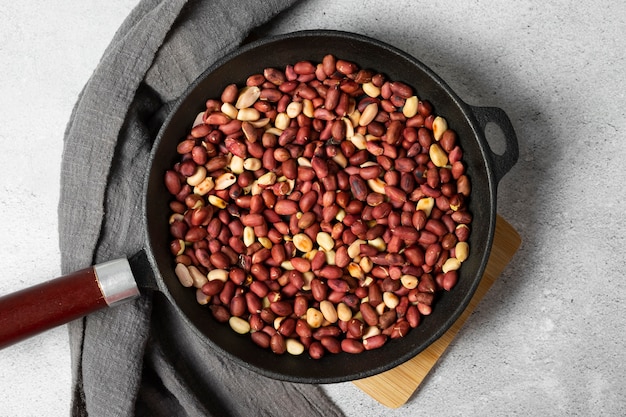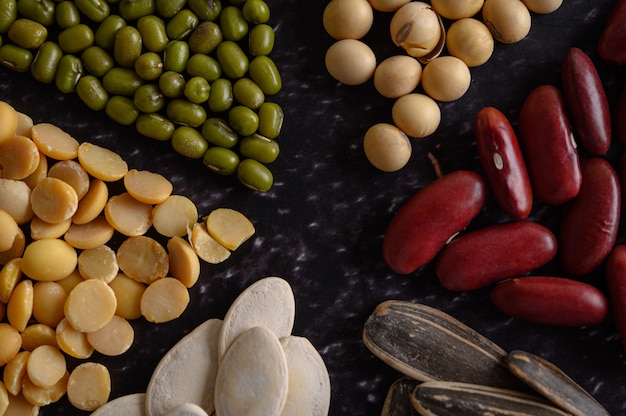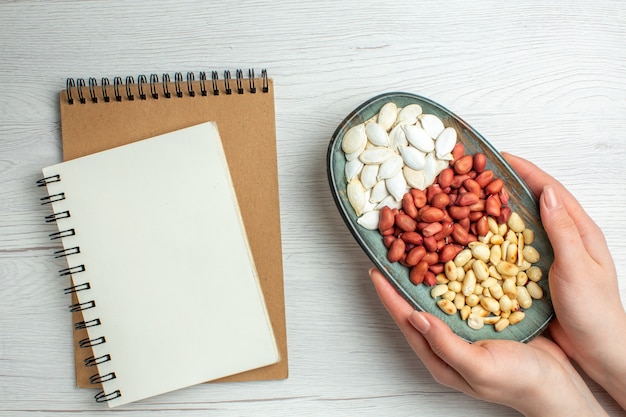There's something truly satisfying about picking out a bunch of vibrant, fresh beans at the market. They promise a delightful crunch, a burst of flavour, and a healthy dose of goodness. But for someone like me, who once considered cooking beans a bit of a culinary mystery, the process of transforming those raw beauties into a delicious dish was a bit intimidating. Over the years, though, I've learned the tricks of the trade, and I'm thrilled to share them with you.
This guide isn't just about boiling beans – it's about embracing the world of fresh beans and unlocking their full potential. We'll cover everything from choosing the right beans to mastering various cooking methods, and even explore some creative ways to incorporate them into your meals. By the time you're done reading, you'll be a confident bean-cooking champion, ready to impress yourself and everyone around you with your culinary skills.
Part 1: Choosing the Perfect Beans – A culinary adventure

A World of Bean Wonders
The first step in any bean-cooking journey is selecting the right beans for the job. The world of beans is incredibly diverse, offering a spectrum of flavours and textures. Each type brings its own unique personality to the table, so it's important to choose wisely. Let's explore a few of my personal favourites:
- French Beans: These are the quintessential green beans, known for their delicate flavour and satisfying snap. They're incredibly versatile, shining in stir-fries, salads, and even as a simple side dish. Think of them as the culinary chameleon of the bean world.
- Runner Beans: These long, slender beauties are characterized by a slightly sweet taste and a tender texture. They excel in roasted dishes, hearty stews, and even summery salads. Their delicate sweetness adds a delightful touch to any dish.
- Broad Beans: These large, plump beans boast an earthy, nutty flavour and a creamy texture when cooked. They are a true culinary gem, adding richness to salads, dips, and even sweet treats. Their versatility knows no bounds!
- borlotti beans: These gorgeous, speckled beans are a favourite for soups, stews, and salads. They have a mild, slightly sweet taste and a satisfyingly firm texture. They’re the perfect blank canvas for your culinary creations.
And don't forget to consider other varieties, such as haricot verts, string beans, and the intriguing purple beans – each with its own unique flavour and character. It's a wonderful world of bean exploration, and there's a bean out there for everyone.
The Importance of Freshness
When you're choosing your beans, always go for fresh ones. You can tell they're fresh by their vibrant green colour, plumpness, and absence of any blemishes. Avoid any beans that look wilted or have brown spots. Trust me, the difference in flavour and texture is remarkable. Fresh beans are a symphony of taste, while their less-fresh counterparts can be a bit of a culinary disappointment.
If you can, try to buy beans directly from a local farmer's market. You'll be supporting local farmers and getting the freshest, most flavorful beans available. It's a win-win!
Part 2: Preparing Your Beans – A Little TLC Goes a Long Way

Before you start cooking, give your beans a little TLC. This simple preparation step makes a world of difference in the final dish.
The Art of Trimming
Begin by trimming off the ends of the beans. For French and runner beans, a simple snip with a sharp knife or kitchen scissors is all you need. Broad beans, however, require a bit more attention.
To remove the tough outer shell of a broad bean, snap it in half and gently peel away the skin. This might seem a little tedious, but it's worth it for the delicious, creamy texture you'll get in your final dish. Trust me, the effort is well worth it.
A Refreshing Rinse
Once you've trimmed your beans, rinse them thoroughly under cold water. This will remove any lingering dirt or debris, ensuring they're sparkling clean and ready for the cooking process. It's a simple step that makes a big difference in the overall taste and texture of your beans.
Part 3: Basic Boiling – The Foundation of bean cooking

Simplicity at its Finest
Boiling is the most straightforward way to cook beans. It's a perfect method for preserving their vibrant colour and tender texture. Simply add your beans to a pot of boiling water, bring it back to a boil, and then reduce the heat to a gentle simmer.
Simmering to Perfection
The simmering time depends on the type of bean and the level of tenderness you desire. For French beans, I usually simmer for about 3-5 minutes. For runner beans, it might be a bit longer, around 5-7 minutes. You'll know they're done when they're bright green and tender but still have a slight bite. Overcooked beans can become mushy, so it's important to keep a close eye on them.
Flavour Boost
Don't be afraid to experiment with flavours. A pinch of salt added to the boiling water enhances the beans' natural taste. You can also add other spices like peppercorns, bay leaves, or even a sprig of fresh thyme for an extra dimension of flavour.
I've discovered that adding a small piece of kombu (a type of seaweed) to the boiling water adds a subtle umami flavour to the beans. It's a little trick I picked up from a Japanese chef, and it truly elevates the flavour profile.
Part 4: Steaming – A Healthier Approach
Preserving Goodness
If you're looking for a healthier way to cook your beans, steaming is a fantastic option. It preserves the nutrients and flavour better than boiling. The gentle heat of steaming ensures that the beans retain their vibrant colour and delicate texture.
Simple Steps to Steam Perfection
Simply place your beans in a steamer basket over a pot of boiling water. Let the steam work its magic, cooking the beans until they're tender. Remember not to overcrowd the steamer basket, as this can result in uneven cooking.
Tips for Successful Steaming
Keep a close eye on your beans while they're steaming to avoid overcooking. You can add a pinch of salt or your favourite herbs to the water for a flavour boost.
Part 5: Roasting – A Crispy Delight
Golden Brown and Irresistible
Roasting beans is a wonderful way to add a crispy texture and a depth of flavour to your dish. It's a simple technique that yields incredibly delicious results.
Roasting Instructions
Preheat your oven to 180°C (350°F). Toss your beans in a little olive oil, salt, and pepper, then spread them out on a baking sheet. Roast for about 15-20 minutes, turning them halfway through. They're ready when they're golden brown and tender, with a slightly crispy exterior.
Adding Flavor Variations
For a more intense flavour, you can add other spices to your roasting mix, such as garlic powder, paprika, cumin, or even a touch of chilli flakes. You can also roast your beans with other vegetables, like cherry tomatoes, onions, or even sliced garlic for a truly flavourful dish.
Roasting beans is a great way to bring out their natural sweetness and create a side dish that complements a variety of main courses.
Part 6: Stir-frying – Speedy Delights
Fast and Flavorful
If you're short on time, stir-frying is your go-to method for cooking beans. It's fast, efficient, and delivers delicious results.
The Stir-frying Process
Heat some oil in a wok or large frying pan over high heat. Add your beans and stir-fry for about 2-3 minutes, until they're heated through and slightly softened. This method allows the beans to retain their vibrant green colour and maintain a slight bite.
Adding Flavor to the Stir-Fry
Once the beans are cooked, you can add other ingredients to your stir-fry, like chopped vegetables, tofu, or meat. Stir-fry everything together until the vegetables are tender and the flavours meld beautifully.
For an extra flavour punch, add a splash of soy sauce, oyster sauce, or fish sauce to your stir-fry. It adds a depth of umami that really enhances the overall flavour profile.
Part 7: Pressure Cooking – A Time-Saving Wonder
Efficiency at its Best
Pressure cooking is a revolutionary method for cooking beans. It's incredibly fast and efficient, cutting down cooking time by at least half. This is especially helpful when you're short on time or want to prepare a large batch of beans for the week.
Steps to Pressure-Cooked Beans
Simply add your beans to your pressure cooker with a little water, seal the lid, and cook according to the manufacturer's instructions. The pressure cooker does all the work, ensuring perfectly cooked beans in a fraction of the time.
Tips for Pressure Cooking Beans
Don't overfill the pressure cooker, and make sure there's enough liquid to cover the beans. Also, be careful when releasing the steam pressure. It can be hot, so always follow the manufacturer's instructions for safe release.
Part 8: Sauteing – A Gentle Approach
Delicate and Delicious
Sauteing beans is a gentler method that results in a tender, slightly crisp texture. It's a great option for those who prefer a more delicate touch to their cooking.
Steps to Sauteed Perfection
Heat some oil in a frying pan over medium heat. Add your beans and cook for about 5-7 minutes, stirring frequently, until they're heated through and slightly softened. Don't overcook them, as this can result in a mushy texture.
Adding Flavour to Sauteed Beans
While sauteing, you can add garlic, onions, or other herbs and spices to create a flavourful dish. For example, a sprinkle of garlic powder, a pinch of paprika, or a few fresh thyme leaves can elevate the flavour profile of your sauteed beans.
Part 9: Serving Your Perfect Beans – A Culinary Symphony
Simple Delights
Cooked beans are delicious on their own, simply seasoned with salt and pepper. They make a perfect side dish for any meal.
Beyond the Basic
But why stop there? Get creative and use your cooked beans in salads, soups, stews, dips, and even desserts. The possibilities are endless. Here are a few ideas to inspire your culinary adventures:
- Salads: Add cooked beans to your favourite salads for a boost of protein and flavour. They work beautifully with grilled chicken, avocado, and a light vinaigrette dressing.
- Soups and Stews: Cooked beans are a staple ingredient in hearty soups and stews. They add a rich texture and a satisfying depth of flavour. Try them in a classic minestrone soup, a hearty lentil stew, or a creamy tomato soup.
- Dips and Spreads: Blend cooked beans with herbs, spices, and a touch of lemon juice for a delicious dip or spread. Serve it with crackers, vegetables, or even as a topping for grilled sandwiches.
- Desserts: Yes, you read that right! Cooked beans can even be incorporated into desserts. Try adding them to a chocolate cake recipe for a moist and delicious treat. You won't even taste the beans, but they'll add a wonderful texture and depth of flavour.
The beauty of beans is their versatility. They can be incorporated into a wide range of dishes, offering endless culinary possibilities.
Part 10: bean storage – Keeping the Goodness Fresh
Refrigeration for Freshness
Store your cooked beans in an airtight container in the fridge for up to 3 days. They'll retain their freshness and flavour for a few days, making them perfect for meal prep or quick and easy meals throughout the week.
Freezing for Long-Term Storage
For longer storage, you can freeze your cooked beans. Simply let them cool completely, then transfer them to freezer-safe bags or containers. They'll keep in the freezer for up to 3 months.
When you're ready to use them, simply thaw them overnight in the refrigerator. You can even add them directly to soups or stews without thawing, as the heat from the cooking process will defrost them quickly.
Part 11: FAQs
1. How do I know if my beans are cooked?
You'll know your beans are cooked when they're tender and no longer have a raw, crunchy bite. You can test them by piercing them with a fork. If they pierce easily, they're ready.
2. What if my beans are too crunchy?
If your beans are too crunchy, simply cook them for a few more minutes. They'll soften as they cook.
3. What if my beans are too mushy?
If your beans are too mushy, you probably overcooked them. There's not much you can do to salvage them, but next time, try cooking them for a shorter time.
4. Can I use frozen beans?
Absolutely! Frozen beans are a great convenience. Just make sure to defrost them before cooking. You can defrost them overnight in the refrigerator or quickly in the microwave.
5. What are some tips for cooking different types of beans?
Here's a quick table outlining cooking tips for different bean varieties:
| Bean Type | Cooking Time (minutes) | Tips |
|---|---|---|
| French Beans | 3-5 (boiling) | Cook until tender but still slightly crisp. |
| Runner Beans | 5-7 (boiling) | Cook until tender, but avoid overcooking. |
| Broad Beans | 10-15 (boiling) | Remove the tough outer shell before cooking. |
| Borlotti Beans | 20-30 (boiling) | Cook until tender, but not mushy. |
Now you're armed with all the knowledge you need to cook fresh beans like a pro. So get out there, find those beautiful beans at the market, and start experimenting! Remember, the best way to learn is to have fun with it. And don't be afraid to try different methods and flavours – you might surprise yourself with what you create!
Everyone is watching

How to Cook Frozen Lobster Tails Perfectly: A Step-by-Step Guide
RecipesLobster. Just the word conjures up images of lavish meals, special occasions, and a taste of luxury. But let's...

Pigs in a Blanket Cooking Time: How Long to Bake for Perfect Results
RecipesAh, pigs in a blanket. Just the name conjures up images of those delightful little parcels of crispy pastry en...

Pork Fillet Cooking Time: How Long to Cook It Perfectly
RecipesPork fillet, or tenderloin as it's sometimes called, is a real favourite in our house. It's so versatile, and...

The Ultimate Guide to Cooking Delicious Frankfurters
RecipesLet's face it, we all love a good frankfurter. It's a classic, simple, and always satisfying. But let's be rea...

Wolf Meat Recipes: A Guide to Cooking Wild Game
RecipesLet's be honest, you don't see wolf meat at your local butcher shop every day. It's a bit of a wild card, but ...
